Search Engine Optimization (SEO) is a very broad topic and many people have lots of questions about SEO. In this blog post, we will answer Frequently Asked Questions (FAQ) about SEO, which will be helpful for people that are new to SEO, as well as professionals that want to refresh their knowledge about SEO.
Since there are so many questions about SEO, we’ve grouped them into different categories. Feel free to skip ahead to the category you’re interested in. The categories are the following:
- Basic SEO Terms Explained
- On-page SEO
- Off-page SEO
- Backlink building
- Keyword research
- Local SEO
- Technical SEO
- Advanced definitions
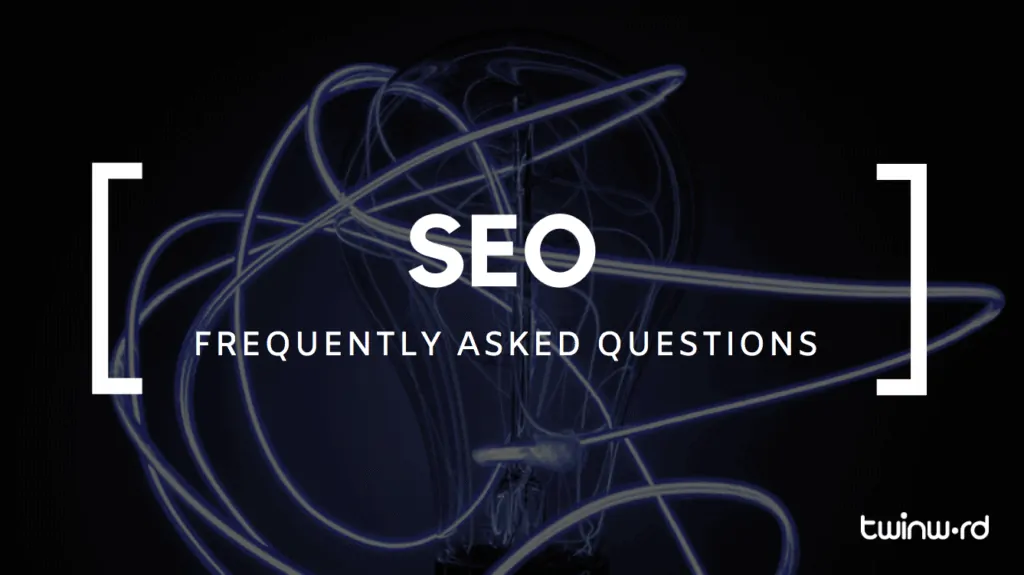
1. Basic SEO Terms Explained
What Is SEO?
SEO stands for Search Engine Optimization, which means making certain changes/improvements on your website or blog to increase its visibility on search engines. This is to attract organic (unpaid) traffic to your website and to rank high on the SERP (Search engine result pages).
Why Is Search Engine Optimization (SEO) Important For My Business?
SEO is important for your business because it can lead to more organic website traffic. Organic traffic is unpaid traffic that you get from people finding your website through search engines like Google. As you know, search engines are used by people all over the world to get information. This means that you can reach a lot of people with just one web page or blog post if it appears high on search engines.
What Is A Search Engine?
A search engine is a system where users can search the internet for content by typing in a search term. Then, a search engine looks through its index and shows relevant results in the form of a list. Google and Bing are popular examples of search engines.
What Is A SERP?
If you are new to SEO, you are probably wondering what SERP means. SERP stands for ‘search engine results page’. This is the page that you receive after searching for a query on search engines. On the SERP you will receive both organic results and paid advertisements.
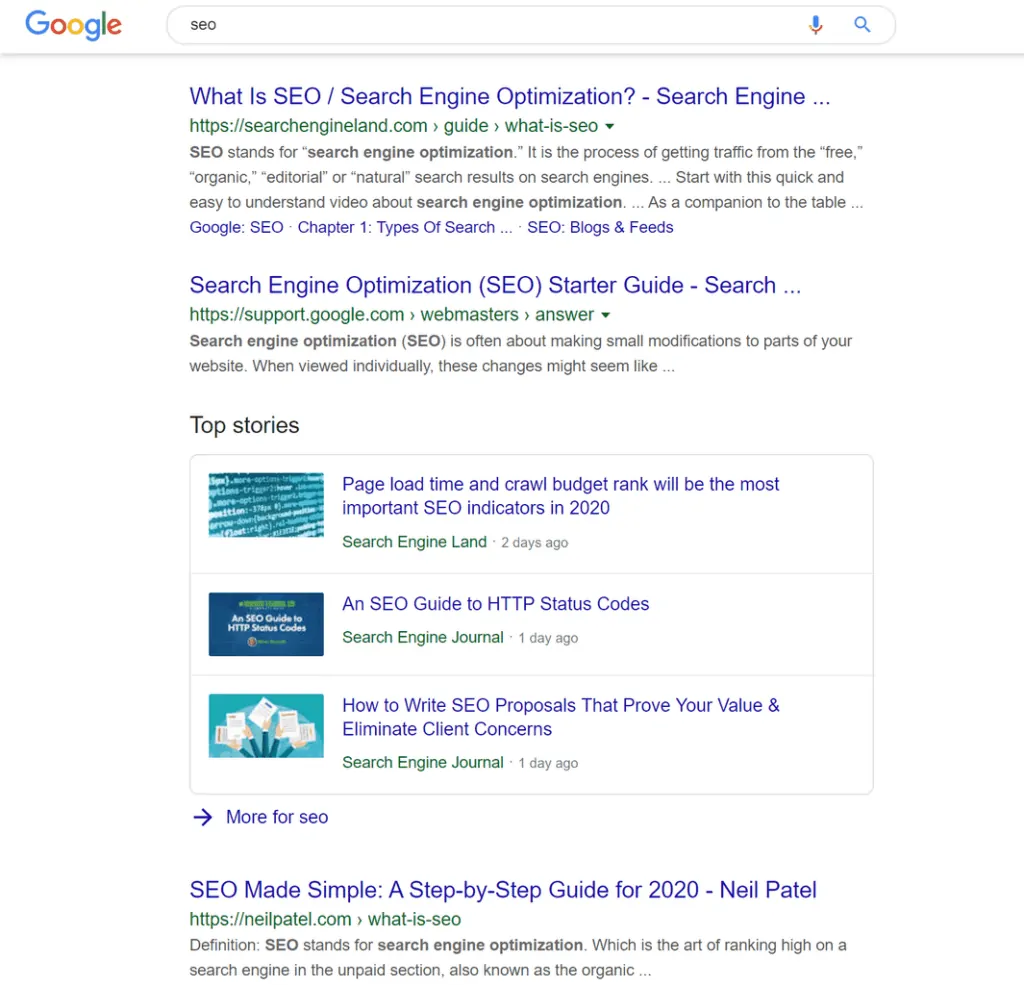
What Is White Hat SEO?
White hat SEO is optimizing your website according to the guidelines of search engines. For example, on Google, you have to follow the webmaster guidelines. Next to the guidelines, it is important to always keep your users in mind because the top goal of search engines is to provide users with the most relevant results. Here are four white hat SEO techniques that you can use:
- Keyword research: Searching for relevant keywords for users based on different metrics. The most ideal keywords are the ones with high search volume and low competition. Using these relevant keywords can help you rank higher on the SERP. Check out how to perform keyword research in the keyword research section.
- Enhanced website design and navigation: Your website should have a clear design which is easy to navigate through. This will be a better user experience for your site and a lower bounce rate. A lower bounce rate will be more advantageous for your ranking on the SERP.
- Create valuable content: Writing relevant content for your users is one of the rules of SEO. Your users will like unique and relevant content. You can look at what kind of content your competitors are producing and try to add some additional information to that.
- Link building: Link building is also an important part of SEO. Websites that rank high on the SERPs have a lot of quality backlinks which shows their credibility. Build links by reaching out to people instead of buying them. Make sure that the links are of high quality and from the same industry as you are in.
What Is Black Hat SEO?
Black hat SEO is the opposite of white hat SEO, which means that black hat SEO techniques violate the SEO guidelines of search engines. There are different black hat SEO techniques that you should avoid at any cost. Using one of these techniques to rank higher can result in your page being de-indexed and not rank at all.
- Cloaking: Cloaking is a technique used to trick both search engines and users about the content of a web page. Search engines will receive made-up content while users get redirected to other web pages with irrelevant content.
- Keyword stuffing: Keyword stuffing is an SEO technique where you literally stuff way too many keywords into your content, meta tags, and anchor text because you want to rank high on the SERP. This is what everyone did back in the days before Google’s major algorithms, but now, it is seen as an ineffective method that can cause you to get lower in the rankings and to get penalized by Google.
After having written your content, check your keyword density to avoid keyword stuffing. Keyword density is the number of times a keyword is used divided by the total number of words in an article. - Duplicate content: Copying content from another website and pretending it is your own content is not allowed by search engines. Thus, when search engines find out that you’re using someone else’s content without properly citing the source, your page will be de-indexed. So, make sure to link back to the original author when copying content.
- Doorway and gateway pages: These web pages are irrelevant to users, but they include many keywords. While on these pages users get redirected to other websites, the difference with cloaking is that these pages are visible to search engines. There are instances where those web pages get indexed and ranked but eventually, search engines will find them.
- Clickbait: Nowadays, websites are using clickbait titles and images to drive more clicks and traffic to their pages. Because of these misleading titles and images users will click on it because they are curious. But when users find out that the content is irrelevant, they will exit the page immediately, which results in an increase of your bounce rate.
- Link buying: Sometimes people buy links from other sites to get a higher ranking on the SERP. Next to link buying being against Google’s guidelines which can lead to de-indexing, most of the times the website that links back to you is from a low-quality site and has a lot of spammy content anyway. This will result in lower backlink quality and lower Domain Rating (DR).
What Is On-page And Off-page SEO?
On-page SEO refers to all the changes that you can make directly within your website or blog to rank higher on the SERP. Certain factors are affecting On-page SEO which include:
- Title tag
- Meta description
- Headings
- Alt text
- URL structure
- Internal linking
- Page load speed
We’ll go more into detail in the On-page SEO section.
Off-page SEO refers to actions that you can control which are not on your website, which include backlink building, social media, and guest blogging.
2. On-page SEO
What Is A Title Tag And Why Is It Important For SEO?
A title tag is the blue clickable headline or title that you can see on the SERP. Title tags are important because it helps search engines and users understand the content of your web pages. Furthermore, for users, it is the first thing they see on the SERP and will help them decide if they should click on the website or not.

Keep the following points in mind to create the most optimal title tag.
Title length: First, you need to check your title length. Don’t go over the maximum amount of characters of 60 characters or otherwise, there is a higher chance that search engines will cut text that includes your keywords.
Keywords: In addition to this, don’t use too many keywords in your title tag. It will result in bad user experience and search engines might consider it negatively.
Keyword order: Lastly, put your important keywords at the beginning of your title tag to make it easier for users and search engines to see what your content is about. Next to that, search engines might cut off the end of your title tag so you want to make sure that the important part is visible.
What Are Meta Descriptions?
Meta descriptions are the text under the title tag on SERPs. This text needs to clearly explain what your content is about and should include your main keyword. Meta descriptions are especially important for your users to get further information about your content, and to decide whether they want to click on your site or not.

What Is The Optimal Number Of Characters For The Title Tag And Meta description?
While there might be no optimal length, it is important to make sure that your full titles and meta descriptions are displayed on Google. Therefore, you need to be careful not to go over the character limit. Also, keep in mind whether you’re targeting desktop or mobile users.
Desktop:
As already mentioned, the optimal number of characters for a meta description is between 150 and 160 characters. For the title tag, the optimal number is around 55 to 60 characters.
However, Seopressor states that Google has made some recent changes to its SERPs for the title tag and meta description. They changed the space of their SERPs to 600 pixels wide, which is around 100 pixels more than before.
Accordingly, Google can now show more characters than before. We did some research and found this example. As you can see in the picture below, this meta description has a total number of 251 characters displayed.

Mobile:
Originally, the optimal number of characters for a title tag on mobile devices was also between 55 to 60 characters. However, according to SEOpressor, Google has increased the length to 78 characters in 2019.
The maximum number of characters for a meta description is usually up to 130 characters, but, if you check the example of Seopressor, they mention that meta descriptions can have up to 172 characters.
While you should keep the maximum amount of characters in mind, research has shown that shorter titles with 15-40 characters have a higher click-through rate than longer ones. Therefore, next to optimizing your titles for search engines you always need to think of your users and what kind of titles and meta descriptions they will find interesting.
3. Off-page SEO
What Are Backlinks?
Backlink Building: Building backlinks is one of the main techniques used in Off-page SEO. Overall, there are three types of links which are: natural, outreach, and self-created links.
Natural links are links that you received without reaching out to the website owners. This is the best type of link because they’re completely natural and you didn’t have to spend time reaching out to another website to receive the link.
Outreach links are links that you receive from websites after you’ve contacted them and asked for a link. Of course, you will need to explain your reason why they should link to you. You can check out the backlink building section where multiple techniques are explained to help you succeed.
The last type of link is self-created ones. These links are not recommended as they fall under black-hat SEO (which you can find in the SEO definitions section). They are black-hat because you are not given these links by others but because you’re creating them yourself by creating lots of other websites and linking from those websites to your main site.
Other Off-Page SEO Techniques: Next to link building there are other techniques that are used for Off-page SEO. Two of them are social media and guest blogging. Even though social media doesn’t directly help you with your rankings, it still helps you to establish contact with your customers and is a great way to distribute your content. Next to that, guest blogging helps you to advertise your products or services on other websites, brings traffic to your web pages, and is another way to build backlinks to your own site.
4. Backlink Building
What Are Backlinks?
Backlinks are inbound links that your website or blog receives from other websites. That means that another website links to your website. Backlinks can be either embedded in text or images.
Backlinks need to be clickable in order to be recognized as backlinks. For example, using https://www.twinword.com/blog/ will not count as a backlink but https://www.twinword.com does counts as a backlink. Next to that, there are different kinds of backlinks such as Dofollow and Nofollow backlinks, but we’ll talk about that more in detail in the following section.
Why Are Backlinks Important?
Backlinks are a vital part of SEO because they are used as a ranking signal according to Google. With backlinks, it is quality over quantity. So, instead of many low Domain Rating (DR) backlinks, it is better to have a few high DR backlinks.
Next to that, more backlinks will increase your referral traffic and will allow your website to get crawled and indexed faster by Search Engine bots.
What Is The Difference Between Dofollow And Nofollow Links?
The main difference between a dofollow and nofollow link is that a dofollow link will pass its page rank to the other web page, while a nofollow link will not pass its page rank to the other webpage. This means that a dofollow link is helpful for your page rank, while a nofollow link is not.
You can easily find out if a link is dofollow or nofollow by checking if the link has a nofollow tag. This tag looks like this: rel=”nofollow”. 
The reason why nofollow tags were created was to overcome blog comment spam. Spammy webpages would leave their site link in the comments of other websites, which resulted in them ranking higher on Google. But with the nofollow tag, that is not the case anymore as most blog comments are automatically nofollow.
What Are Backlink Building Techniques To Use For SEO?
There are several easy backlink building methods that you can use for your SEO. They are the following:
- Backlink Poaching: The backlink poaching technique is used by finding websites that are linking to your competitors and to content that is similar to yours. Since they’re linking to similar content, this means that they could link to your website too. But how to find these websites?
The first thing to check is your competitor’s backlinks. You can do that with handy tools like Ahrefs or SEMrush. You can easily check dofollow backlinks based on any kind of platform and language. Once you’ve found those sites that link to similar content, you’ll need to reach out to them and ask for a backlink. - Broken Backlink replacements: You have probably come across 404 errors on websites before (check the technical SEO part for explanation). These 404 errors are also referred to as broken links and they’re very bad for your SEO.
All you need to do is to check for 404 errors on websites you’d like to receive a backlink from and let the owner of the website know that you found a broken link on their website. At the same time, you can ask them if they would be willing to switch it with a link to your content. To find broken links, you can use many SEO tools but Ahrefs is highly effective in finding 404 errors. - Guest Posting: Guest posting is exactly what the name suggests. You are posting a blog as a guest on other websites. Through guest posting, you can include links that will go to your website,which can generate extra backlinks for you. You can find websites that are accepting guest posts through Google by entering “your keyword + guest posting”, or you can directly contact those websites that you’d like to write a blog post for.
- Contact Influencers: It is more difficult to make influencers accept your offer if you don’t have much to offer in return, but it is worth a try because of their reach. Try to find their contact details on either their own or their managers social media accounts and approach them with your product or service. Keep in mind to write short messages and explain your unique selling point to them.
- Internal Links: This is the easiest method out of all of them since it is simply linking back from your own content. It’s very easy, just include links in your own content that are related or add value to the topic you are writing about. However, it is also important not to add too many internal links, so be careful with that. You don’t want your blog to look spammy.
- Affiliate Program: For people and businesses that have a higher marketing budget, they can choose to start an affiliate program. With this method, affiliates can earn a certain percentage of commission through referrals of other users. The benefit for you is that your affiliates will write about your products or services and will give you backlinks.
What Is Domain Ranking And Domain Authority?
Domain Ranking and Domain Authority are both scores that got developed to rank websites and to give an indication of a website’s quality and power. Domain Ranking (DR) is an element created by Ahrefs for ranking websites. The ranking is based on a website’s backlink profile and uses a scale of 0 to 100. Domain Authority (DA) is an element created by Moz for ranking that predicts the ranking of websites on search engines. Overall, both scores are used to rank the quality and authority of websites.
5. Keyword Research
How To Perform Keyword Research?
The best and easiest way to find the right keywords is through using keyword tools. There are several keyword research tools that you can use for your SEO and content marketing. With the help of filters based on volume, word count, keyword difficulty, etc, it will be easier to find the right keywords for your website and content.
There are many paid and free keyword tools that you can use for finding the right keywords. We have identified a list of the best tools.
Twinword Ideas will help you find any short, long -tail, and LSI keywords. You can use the smart filters to segment and find the optimal keywords that you need. Some of these smart filters that you can apply are user intent, word count, search volume, etc. This tool has a limited free guest plan and there are several paid plans depending on how many searches you need.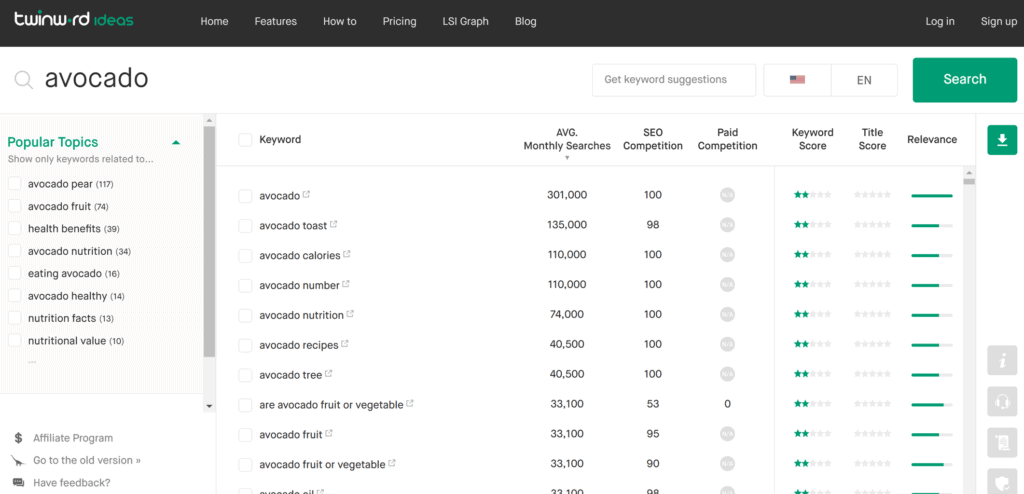
2. KWFinder
KWFinder is a solid keyword research tool. It gives you plenty of keyword ideas based on different metrics like search volume or keyword difficulty. Other features that KWFinder provides are analysis of backlinks, SERP, and you can track your website rankings. KWFinder is free to use with a limited number of features. There is also a paid plan. 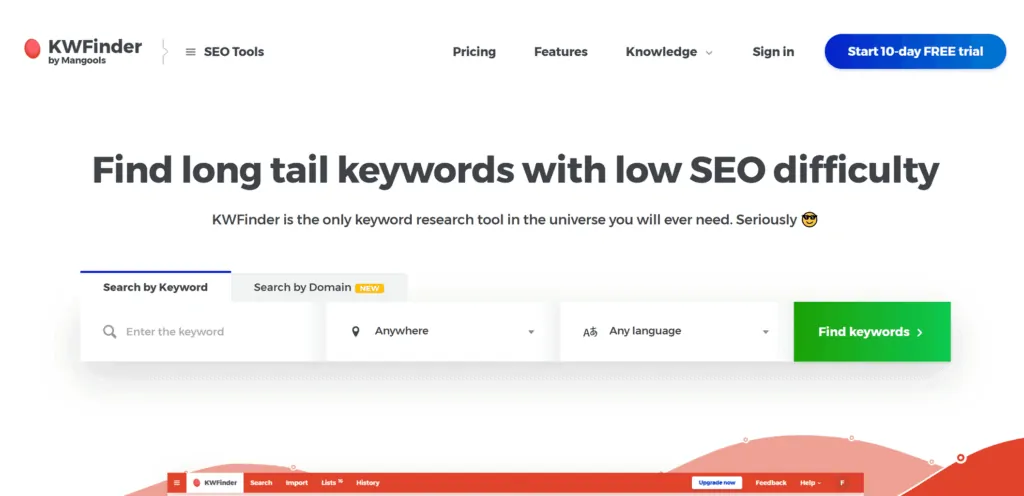
Moz keyword explorer provides you with keyword suggestions. You will see the estimated search volume and keyword difficulty. There is a free plan but it is limited to ten link queries and 50 rows of data per search term every month. This is only applicable when you register and make an account.
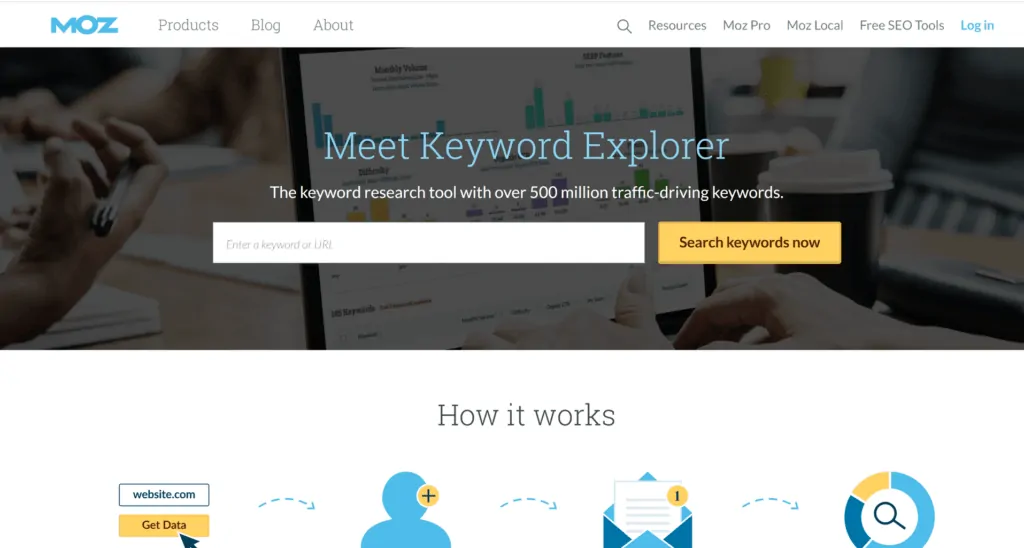
4. Ubersuggest
Ubersuggest is another tool that provides you with keyword suggestions. Furthermore, you can also see the keywords your competition ranks for and see the search volume, CPC, and SEO difficulty for each keyword.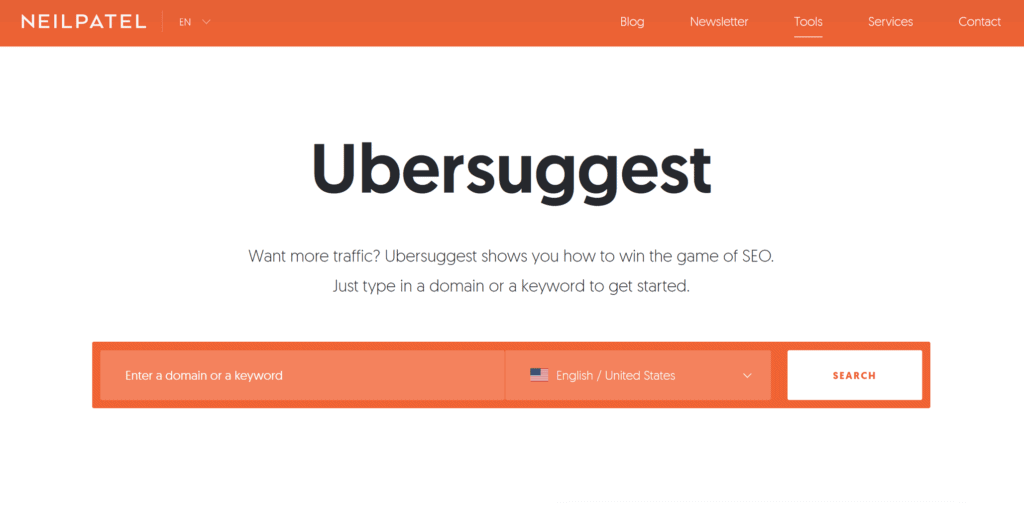
What Are The Best Tools For SEO?
The best keyword research tools for SEO are already mentioned above, so if you’re looking for those, scroll up again. Here we will introduce some of the more general tools that are great to use for SEO.
Google Analytics: Google Analytics (GA) is a free tool provided by Google that shows an analysis of your visitors on your website. This tool is important for SEO because it allows you to monitor and improve your SEO performance.
Google Analytics has many features that you can use for your analysis. For example, you can find out through which source and medium your visitors access your website. Or, you can segment your results based on new and returning visitors.
Google Search Console: Google Search Console (GSC) is another free tool from Google. With this tool, you can monitor your website’s whereabouts in the search result. GSC can help improve your SEO with the help of many features. You can submit sitemaps, fix indexing problems, combat troubleshoot issues for mobile users, check your keyword performance, etc.
Yoast SEO: If you are using WordPress for your blog, the Yoast SEO plugin will make your SEO so much easier! You can optimize your title tag and meta description, generate sitemaps, and check the SEO analysis of your post.
Grammarly: A must-use tool for your website and blog optimization. This tool will show you all the spelling and grammar mistakes that you didn’t notice. To give the best experience to your readers and users, you need a site or blog that’s easy to read and understand, and there’s no room for spelling or grammar mistakes! And obviously, If users don’t enjoy your content and search engines can’t understand your content, it will not rank high on the SERP.
Screaming Frog: Screaming Frog is a super helpful tool that will help you with your technical SEO. Its main functions are to crawl your website, generate sitemaps, and check response codes. Screaming Frog has a free version that works well but there is also a paid plan that you should get if you use it often.
What Is The Search Volume Metrics For Keywords?
Search volume is the average number of searches by users. This number is not always accurate because every keyword tool has its own algorithms for calculating search volume, and because it is only an average of past searches, but it gives you a good indication on which keywords are more popular.
Are Higher Search Volume Keywords Better Than Lower Ones?
While high search volume keywords can be great, there are many cases where low search volume keywords are the better choice. This is the case especially for businesses that don’t have a high spending budget. You are probably wondering why because you think that you reach more people than with a lower search volume.
But, take a look at the drawbacks of high search volume keywords:
- For high search volume keywords, you will need to pay a high price to rank high. The reason for this is because you have more competition than with low volume keywords. Everyone wants to rank for those keywords because a lot of people are searching with those keywords.
- Another problem is that your bounce rate will be probably much higher than before because your website or blog is most likely irrelevant for what the user is looking for. The reason for this is because the keyword is not specific enough for the intent of the user.
Next, check out the benefits of keywords with a low search volume:
- The competition of lower search keywords is way lower than with high search volume keywords. Not a lot of users are searching for something specific with high search volume keywords. Mainly, because they don’t know their intent yet and are trying to find out. This is related to the next benefit.
- The conversion rate is high because people know their intent. They are looking for something specific and are ready to purchase that product or service. For example, someone that is searching for a satin blue a-line dress is closer to the buying stage than someone searching for dresses.
- The cost-per-click (CPC) is cheaper because the search volume is lower. These keywords can result in lower potential traffic than with high search volume ones which is the reason why.
What Are Long-tail Keywords?
Long-tail/short-tail keywords are somewhat related to high and low search volume keywords.
Short-tail keywords are more general and shorter terms that consequently have a higher search volume. Examples would be keywords like ‘running shoes’. They will not contribute a lot to your conversion rate but you gain more exposure. More traffic can have a positive effect on your organic ranking.
Long-tail keywords are specific search terms, such as ‘yellow running shoes for women’. They usually contain three or more words and you can identify what people’s intent is. While these keywords have lower search volume, they can lead to higher conversions.
How Can You Find Long-tail/Short-tail Keywords?
You can use several tools to find good long-tail and short-tail keywords.
One tool you can use Google’s autocomplete tool. These are suggestions that are related to the searches people are looking for. Just type in your main keyword in the Google search bar and press “space” instead of “enter”. It will give you multiple suggestions which can be your long-tail keywords.
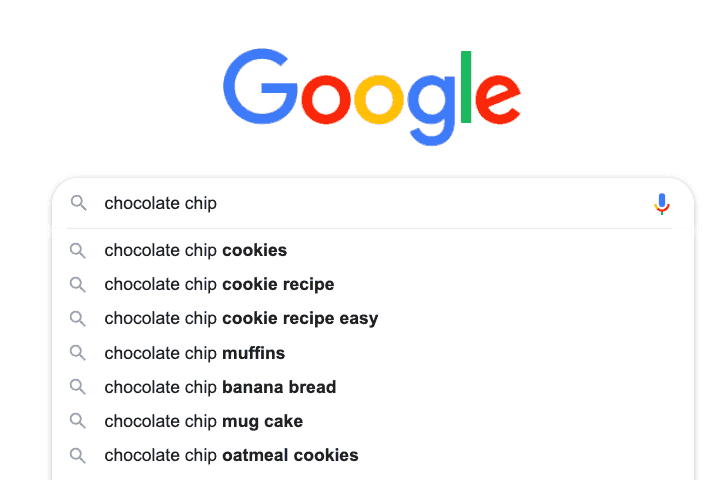
Another method on Google that you can use is the ‘searches related to’ tool. Again, type in your main keyword but press enter this time. Next, scroll all the way down to the bottom of the SERP where you will see searches related to + your keyword.
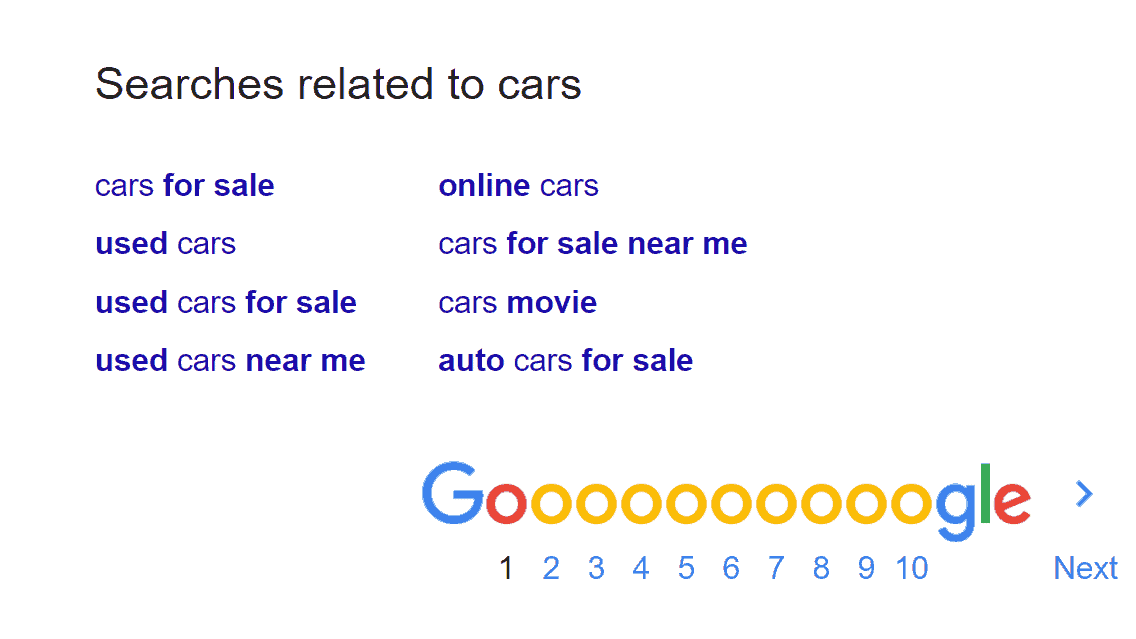
Next to that, another helpful feature is the “people also ask” box on Google. It will mainly pop up for question search terms, and you will receive related questions that users are asking about the topic.

In addition to Google, you can find long-tail keywords by looking at Q&A sites and forums. Popular Q&A sites are Quora and Reddit. In the headings and content, you can find out the user’s intent and identify the keywords.
Another great tool to mention is Twinword Ideas research tool. This tool can generate long-tail keywords for you in seconds. One of the filters is the word count filter on the left side. If you want a specific number of words included or excluded, then you can add a custom filter. For example, to show only long-tail keywords that are longer than four words exclude one till four.
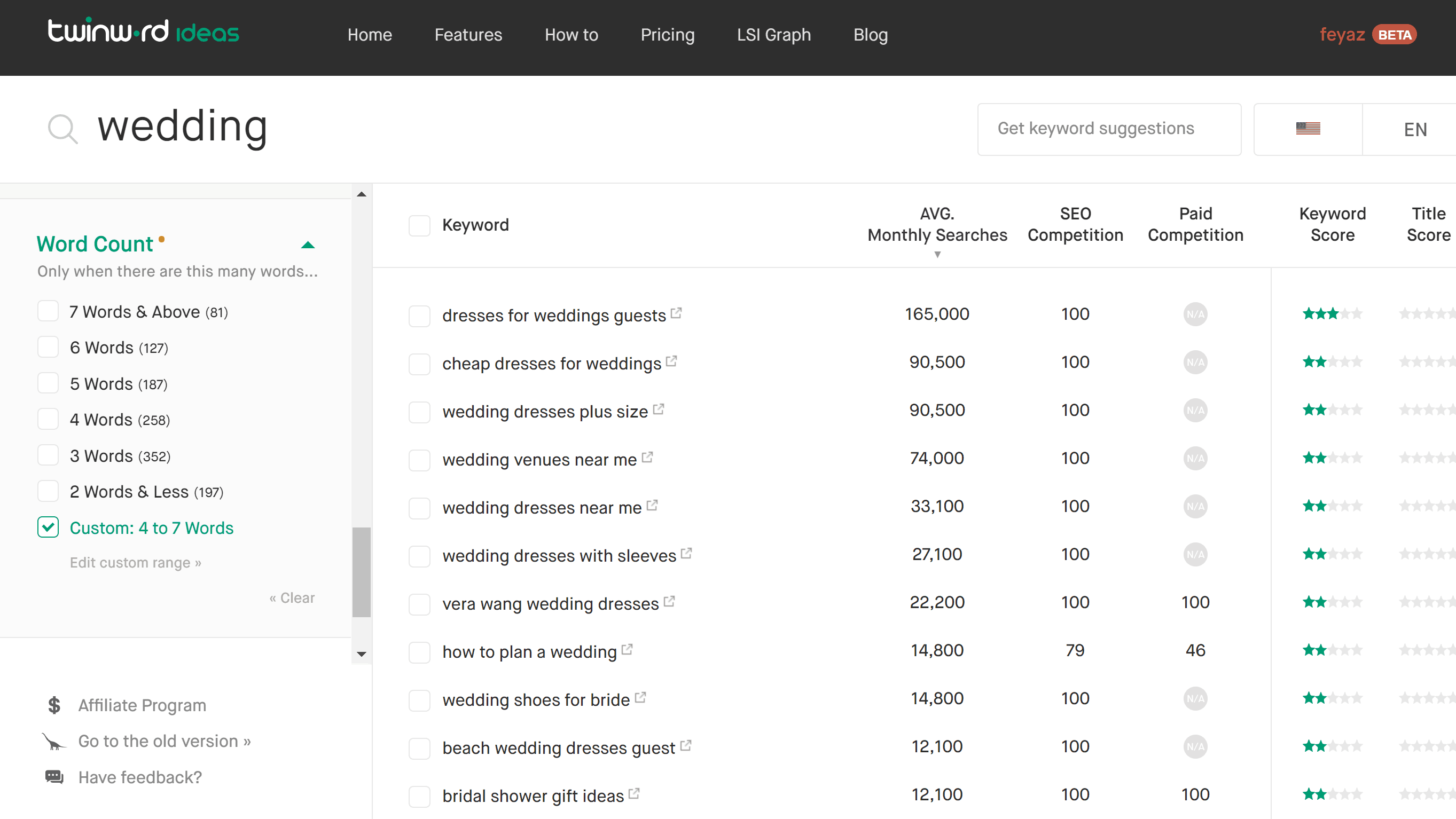
What Are LSI Keywords?
LSI stands for Latent Semantic Indexing. LSI keywords are words and phrases that are related to your main keyword. This method is used by search engines like Google to analyze and understand the context of your webpage. LSI keywords are not synonyms, but keywords that are correlated to your main keyword.
For example, you use the main keyword apple on your page. So, how does Google know if you are writing about the fruit or the company? By analyzing the LSI keywords.
If you use the keywords ‘red apples’, ‘green apples’, and ‘apples calories’ in your content, then Google assumes that you are talking about the fruit. While if you use ‘Apple iPhone 11’, ‘apple store’, ‘apple MacBook air’, then Google assumes that you are writing about the company Apple.
How To Find LSI Keywords?
You can use Google’s ‘autosuggest’ and ‘searches related to’ tools which are also used for finding long-tail keywords. With LSI keywords pick the terms that make sense to use in your post and start adding parts of those terms to your content.
Next, there are tools that are specifically used for generating LSI keywords ideas, such as Twinword Ideas LSI Graph, LSIGraph, and LSIKeywords. They all follow the same process by entering your main keyword in the search bar. And in return, you will get LSI keywords that you can use in your content.
6. Local SEO
What Is Local SEO?
Local SEO is the optimization of your website for the promotion of selling products and services to local customers. One way to optimize for local SEO is using a certain element which is called Google My Business (GMB). GMB is a listing of your business profile that customers can find on Google.
This GMB business profile can display different information depending on what you provide. For example, your products, business description, contact info, location, and opening hours. The GMB element is part of Local SEO ‘citations’.
What Are Local SEO Citations?
Local SEO citations is a place where any of your NAP information (Name, Address, Phone Number) is visible. NAPW stands for Name, Address, Phone number, and Website URL. This is mostly available on business directories. Google’s latest update for local search results meant that Google is now using neural matching for local search results globally.
This update resulted in local ranking changes on the SERP, as it allows Google to have a better understanding of when the search terms of users are with a local intent. Even when the NAP or business description is not included.
Find out more about user intents.
7. Technical SEO
What Is The Ideal Page Speed Of Any Content For Better Ranking On The SERP?
According to Google, the ideal page speed for your website should be under three seconds. Longer than three seconds can lead to a loss of 53% of visits to your website. You can check out your page speed through Google’s PageSpeed Insights. The tool analyzes your website and gives you suggestions on how to improve the speed.
What Is Crawling And Indexing In SEO?
Crawling and indexing are related to each other. But search engines can’t index without having crawled first. Basically, Google sends its spider crawlers to crawl and analyze your website. After this step, Google can index your web pages into their system which means it will add your web pages to Google search. When a user is typing a search term, Google will show relevant web pages from their index based on the keywords in the search term.
What Is Robots.txt?
A robots.txt file is a file where you can specify to search engine crawlers which pages can be crawled and indexed, and which not. There are two reasons why you should have a robots.txt file.
First, you want to keep a certain media or resource files from showing up on Google.
Second, you want to manage the amount of traffic from crawlers to your website.
Remember that you should not rely on robots.txt to hide your web pages from Google search results, because that webpage can still end up being displayed on the SERP if there is another page that links back to it. You should either use the noindex tag or create passwords for your files/pages to make sure that certain content isn’t displayed on SERPs.
What Are 404 Errors?
You probably have been there before. You visit a website and instead of the content, a 404 error shows up saying that the page is not available. A 404 error can be the result of various reasons. The main reason is when the content of a website has been removed or moved to another URL without a proper redirection. The other reason can be that you typed the URL wrong.
Generally, 404 errors are bad for user experience and should be fixed as soon as possible.
What Is An XML Sitemap?
An XML sitemap is written for search engines and is a file with which crawlers can find and crawl your webpages. It is an easy and fast method to let search engines know about the new content you’ve added or the old content you’ve updated.
If you are using WordPress, you can use the Yoast SEO plugin. This plugin can generate an XML sitemap. If not, you can use many other tools like this one to create a sitemap. With this tool, you can create a sitemap with up to 500 pages for free.
What Is An HTML Sitemap?
A sitemap is a file which lists the webpages of a domain. With this file, you make sure that Google finds all your webpages so that they can index them properly. An HTML sitemap is written for humans to read. When someone is lost on your website, they can check the sitemap to find the page that they were looking for.
What Is A Canonical URL?
A canonical URL is supposed to prevent the problem with duplicate content. Duplicate content can happen quite easily when you write a blog that falls under multiple categories and the page has multiple URL’s. For example:
https://example.com/blue-dress/a-line-dresses
https://example.com/black-dress/a-line-dresses
To prevent this duplicate content issue, you should use a canonical URL to decide on one URL that best represents the content. That canonical page then gets shown by Google on the SERP.
With a canonical URL you can also indicate which content is the original one. This can be important if you’re distributing your content on several platforms, such as your own blog and maybe a different website. In that case, you need to use a canonical URL to tell Google which content is the original source.
How do you know when a URL is a canonical URL? To find that out, you’ll need to look at the source code and find the “rel=canonical” tag.
How To Perform An SEO Audit?
You can perform an SEO site audit to improve your rankings on the SERP. The easiest way is to use an SEO audit tool. Check out this blog post on free SEO audit tools to find the right tool for you.
In case you don’t want to use any tools, we identified all the requirements needed to perform a site audit without tools:
- Check your search results from your users’ point of view: This step is only for people that advertise their products or services in foreign countries. By using the Google Ads preview tool, you can check your search results depending on a location or device.
- Mobile-friendliness: This has become a ranking factor for Google. You can use Google’s mobile-friendly test to check if your site is mobile-friendly.
- Title tag: It is important to have a good title tag. An explanation with what to include and avoid has already been mentioned before.
- Meta description: Make attractive meta descriptions for users to click on. Even though it is not a ranking factor it is still important for both search engines and users.
- Image Alt tag attribute: This feature is where you explain what the image is about, which is important for search engines and users as well.
- Sitemap.xml: It is important to create an XML sitemap for search engines. This step has already been explained in previous sections.
- Robots.txt: Create a robots.txt file if necessary. Check out the previous question “what is robots.txt? for a detailed description.
- Google Analytics: Google Analytics (GA) is a commonly used tool for SEO. If you are not using it, you should! There are many reasons to start using GA because the information provided will help you improve your website. Some of the benefits are that it is free, you can track your conversions, and you can check through which source people find your website for your marketing campaign, etc.
- Canonical link tags: Like we explained before, canonical tags are used to tackle the problem of having duplicate pages. Just go to your HTML header source code and fill in <link rel=” canonical” followed by the web page that you want to be represented.
- Schema Markup: Schema Markup is a code that you put in your HTML coding. It is for search engines to better understand your content. In addition to this, it can result in featured rich snippets that contain more information than normal search results. Find out more about Schema Markup.
- Open Graph: Open Graph is a number of tags that you can use to control what content (description, image, etc.) is displayed when you or users share a link to your webpage.
- Twitter Card: A twitter card is useful to control the information that will be shown when you or another user shares your content via Twitter. The twitter card allows you to go over the 140 character limit and you can also include an image in the twitter post. What you have to do is to go to your profile icon, click on “Twitter Ads”, then click on “creative”, and select “create a card”.
- Flash: Flash was useful in the past but now there are many problems that are related to SEO. If you have Flash now running on your website, the page speed will be significantly slower than without Flash. Furthermore, it is harder for Google to crawl and index your content inside your flash application. Therefore, it is usually advised to not use Flash.
- Alexa ranking: This is not a necessary step for the site audit, however, the Alexa ranking helps you to see where your website is ranked in comparison with your competitors. The lower the rank is, the better your domain power.
- Analyzing backlinks: It is important to check the amount and quality of your backlinks. As you already know, backlinks are a major ranking factor, so you want to make sure to have as many as possible high quality backlinks. Check out the sections related to backlinks in this post to find out more detailed information on backlinks.
- Increase site speed: According to Google, site speed is a ranking factor on the SERP. Slow website speed is related to a high bounce rate and low dwell time. Try to optimize your site speed by analyzing your website on Google’s PageSpeed Insights. It will tell you what you can improve to increase your site speed.
- Simplifying website structure: This refers to the layout of your website. A website can have two different formats which are either a deep or a flat website structure. A flat site structure has more preference due to the reason that it is easier for users to navigate. And all elements of a website are not far from each other.
8. Advanced Definitions
What Is PPC?
PPC stands for ‘Pay-Per-Click’ which is a paid advertising method. The method is used to generate more traffic to your website, and basically, you will need to pay a fee for each time your ad is clicked. One popular medium for PPC campaigns is search engines such as Google.
When a user is searching for something on search engines and they end up on the SERP, the first results are the paid ads. When a user clicks on your ad, you will have to pay a fee to the search engine ad service.
What Is Click-Through Rate And Bounce Rate?
The Click-Through Rate is the percentage of people who click on your ad out of the total number of people who saw it. This equation is mostly used to measure the success of a PPC campaign, but it is also used in general marketing and SEO campaigns.
Bounce rate is the percentage of people who clicked on a website and immediately leave again before interacting with the site in any way. In most cases, a high bounce rate is perceived as the site not having relevant content for users, and in turn, a low bounce rate indicates that users are satisfied with the web content.
What Is Dwell Time?
Dwell time is the duration of time that someone spends on a webpage before returning to the SERP. A longer dwell time indicates to Google that your content is relevant to the user. Next to that, there is a higher chance for conversions if the dwell time is high.
What Is User Intent?
User intent is the goal or the intent that the user had when typing in a search term. There are different types of user intents, such as Informational, Transactional, Navigational, and Local.
The informational intent is when the user is looking for information, the transactional is when users are ready to buy a product or service, and the navigational intent is when users are trying to access a certain website or blog. The local intent is when people are looking for something near them such as a restaurant or a bank.
Knowing your user’s intent is important for targeting the right keywords and creating the right content. When you have keywords based on the intent, it can result in higher conversion rates. Generally, PPC campaigns tend to focus more on the transactional intent while SEO campaigns often focus more on the informational intent.
Find out more about user intents.
That’s Not All
We identified these questions as the most FAQ’s based on research from Quora. These answered questions can help you further in your journey to rank number one on the SERP. Of course, there are endless questions that you can ask about SEO and this list includes only a few. So, if you have any questions about this blog post or if you want your question answered then don’t hesitate to leave us a comment down below!
If you would like to read more about SEO in general, check out these related articles:
How To Optimize For Zero-Click Searches
SEO Best Practices You Don’t Want To Miss
Where To Put Keywords In Your Blog Posts For SEO


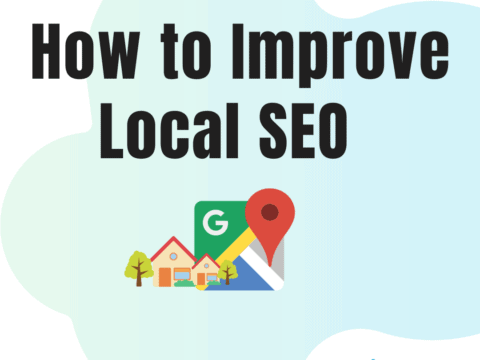
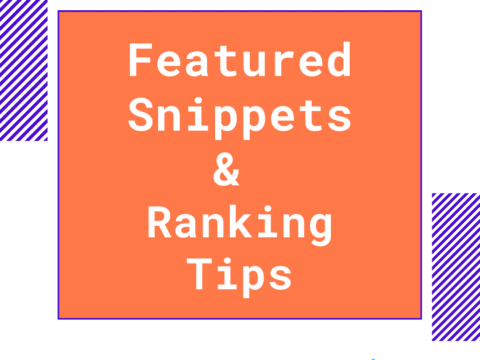
2 Comments
nice article but some still information are missing but you can see here for more detail insights.
These hubs that are 1500 words most likely cover their topic completely and are for that reason ranking well and acquiring the targeted traffic.